Since Dani Carvajal‘s injury against Villarreal, Real Madrid has struggled with their squad and tactics.
Combined with David Alaba‘s injury, Carajal is yet another crucial defensive line player who is injured.
Although they signed Kylian Mbappé and Endrick last summer, Carlo Ancelotti’s main problems relate to his build-up and defensive phase — where Alaba, Carvajal and the retired Toni Kroos were vital.
Now, with Carvajal out, Real Madrid needs to act fast in the transfer market.
Ideally, they should try to kill two birds with one stone by signing a quality player with favourable contract terms.
Since Achraf Hakimi left Real Madrid, Carvajal’s successor is unknown.
Unfortunately, Lucas Vázquez is not a top right-back.
He can’t cover the position if the team has any more problems.
In this Real Madrid tactical data analysis, we will use our proprietary xGOLD tool to examine potential Dani Carvajal replacements in depth.
We will also look at problems in Carlo Ancelotti’s formation and what needs to be improved.
Real Madrid’s Problems: Beating Low Blocks
In recent years,
under Carlo Ancelotti’s coaching style, Real Madrid has primarily relegated itselfto functional play where players are located according to where the ball is, not according to designated zones.
Not many coaches apply this philosophy in top European football, with the 1 exception being Carlo Ancelotti.
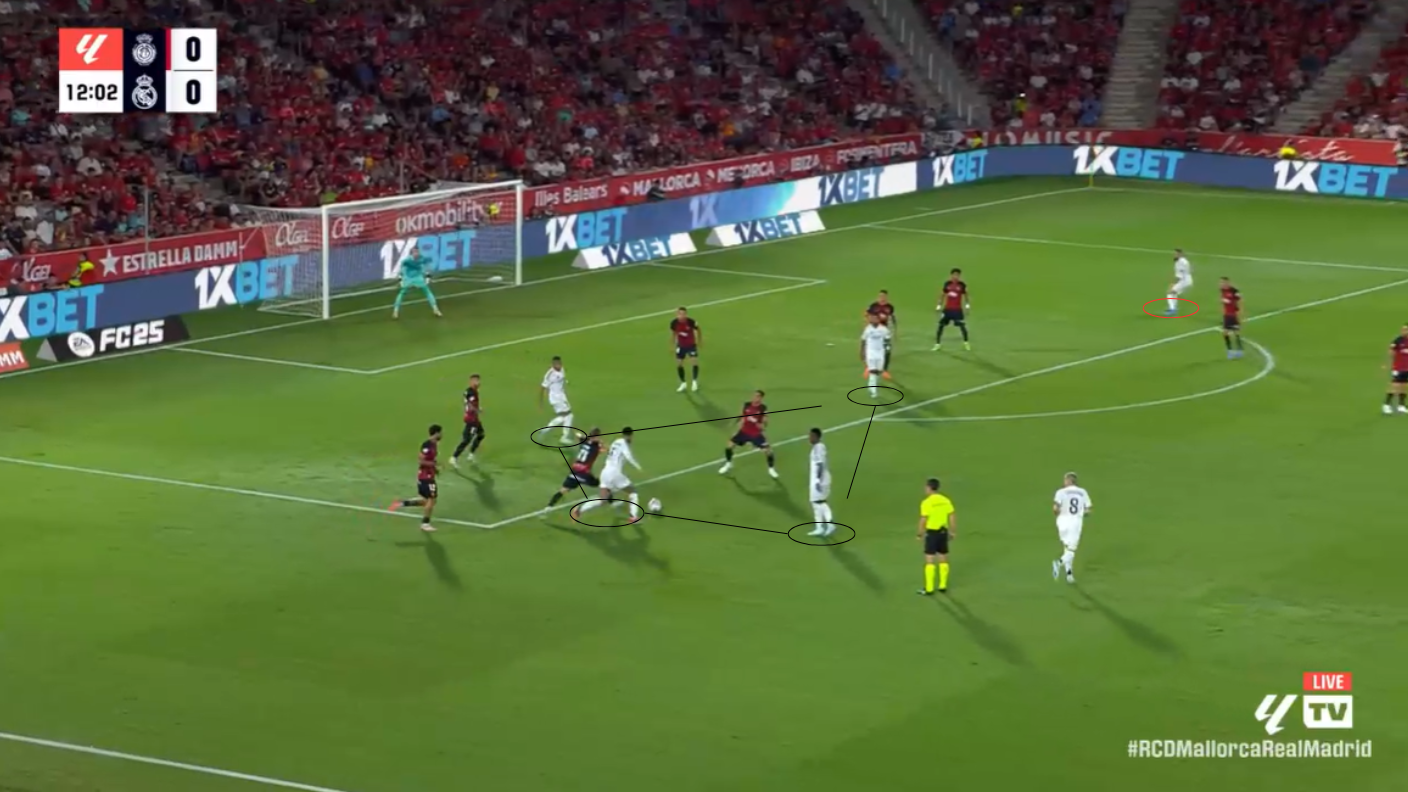
Using that functional play structure, the synergy between the players and the rhythm of the possession are crucial.
This is especially true while attacking to beat low blocks.
Yet in modern football, it is almost impossible to execute something like Figure 1 continuously and successfully.
It is for that reason why Carvajal is so vital.
During the attack, he moves forward to the final line and positions himself wider to create advantages for the strong side, or he can go inside and support at different heights.
He has freedom of movement, although his primary role is wider.
This season, with Kylian Mbappé’s signing and Toni Kroos’ departure, the synergy to break low blocks is not as good as it should be, and that is one of Real Madrid’s major issues.
Real Madrid’s Problems: Build-Up Phase
The other structural problem is in the build-up phase, where Toni Kroos was the leader.
Kroos was capable of making excellent switches from dropping in as centre-back or left-back.
His long-passing range, accuracy with the ball, and tempo-space dominance made him the team’s pillar—the ‘rhythmist’.

Real Madrid lost this stability without Kroos.
Neither Federico Valverde, Eduardo Camavinga, nor Aurélien Tchouaméni have a similar instinct in possession to create constant advantages and dominance.Without Kroos, Madrid’s possessions are more accelerated, meaning they lose more balls per match, and the general tempo is out of control.
Carlo Ancelotti has tried new configurations in this phase, like changing Éder Militão & Rüdiger’s side as centre-backs or Vinicius Junior dropping in in central zones.
However, they still have not found the proper “rhythm”.
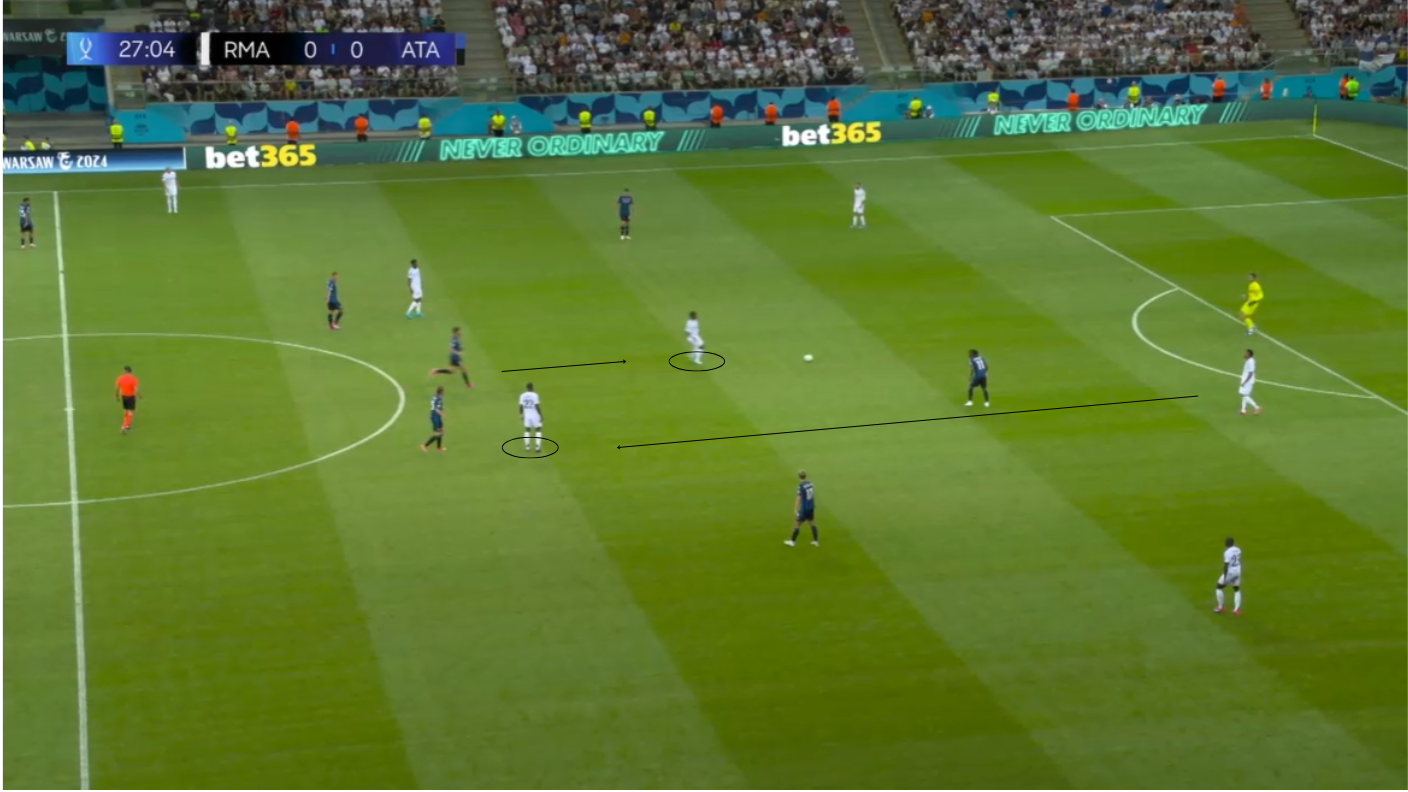
Now that Vini can play in central channels, he may be the best passer of Real Madrid’s XI if Luka Modrić is not there and if Arda Güler does not develop this year.
This is why Ancelotti has made that move.
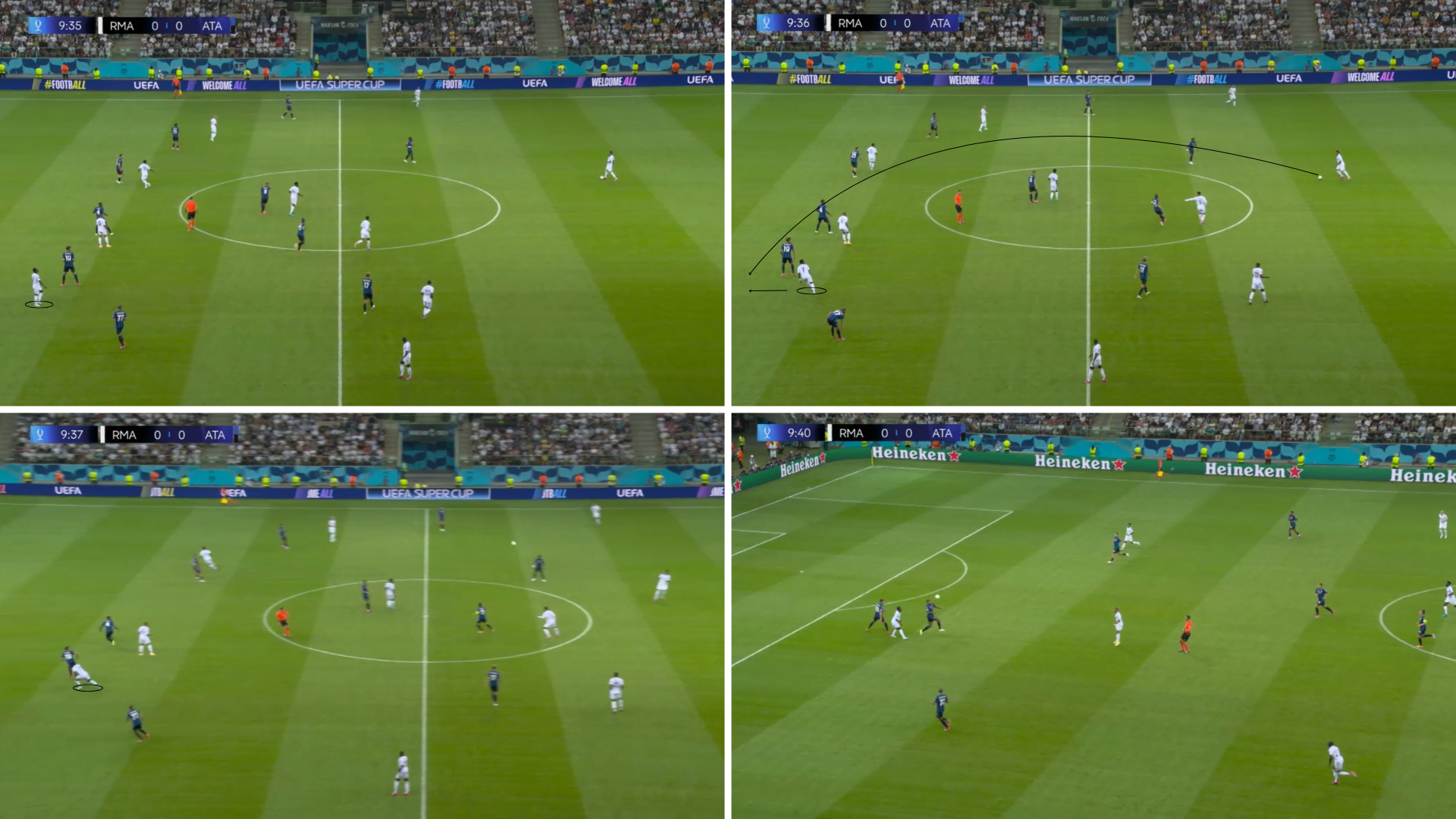
In the axis, Real Madrid does not have a certainty anymore.
Kroos used to complete 100% of his long balls with perfect timing and vision—there is nobody like him in the current Real Madrid formation.
What Real Madrid Is Losing Without Dani Carvajal?
More than build-up structure and positioning in the final third, without Dani Carvajal, Real Madrid are losing a top player for this season.
Carvajal has one of the best crossing techniques from the right side.
In general, his technique with the ball is fantastic.
Dani Carvajal Progressive Passes Map
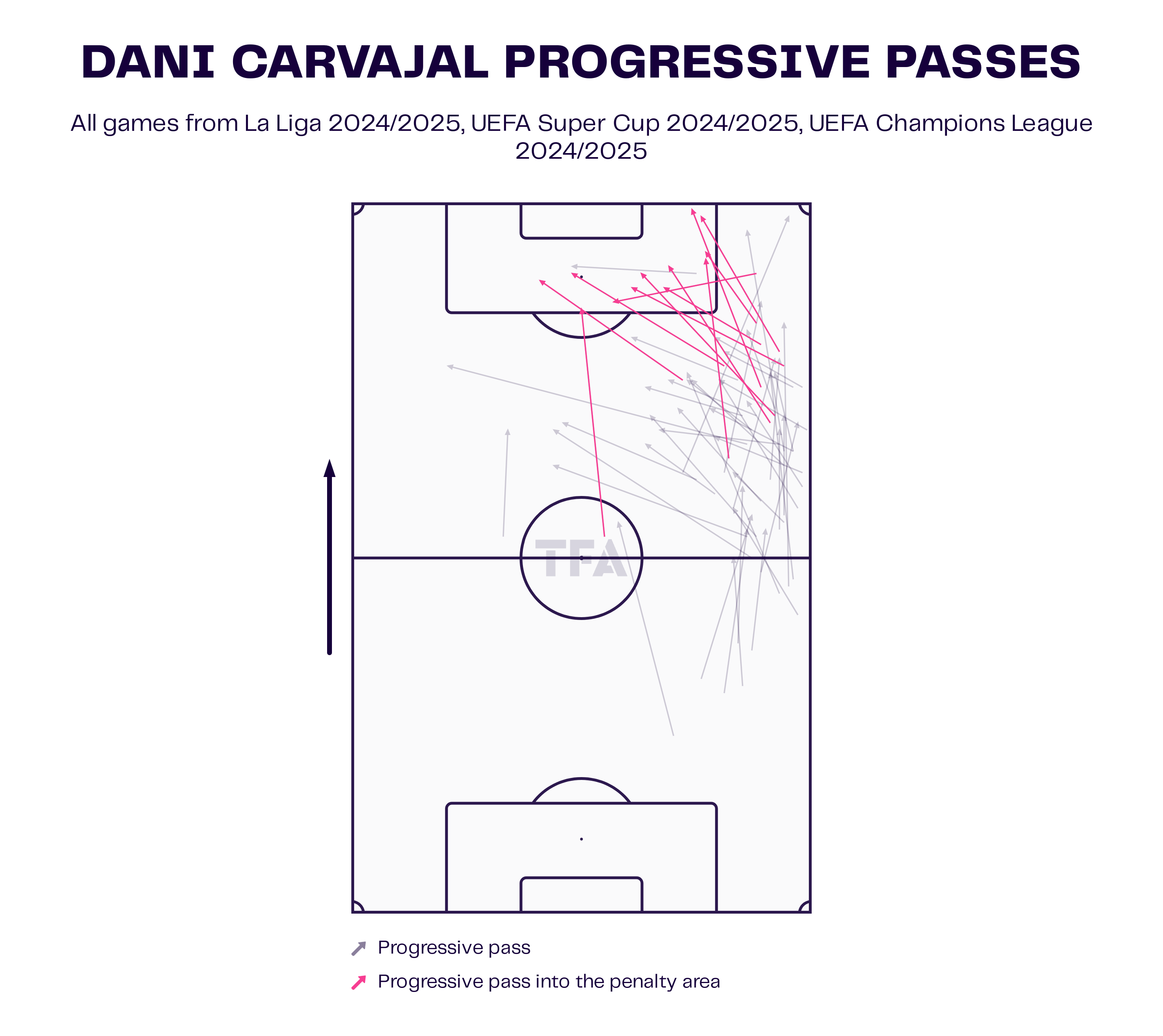
Caravajal has developed a great partnership with Valverde and Rodrygo on his side, exchanging the central, inner, and wide channels between them.
His carrying technique is world-class from wide zones.
He tends to penetrate the opposition’s box, combining a powerful lower body with velocity to execute passes, crosses or shots.
Dani Carvajal Penetrating Carries Map
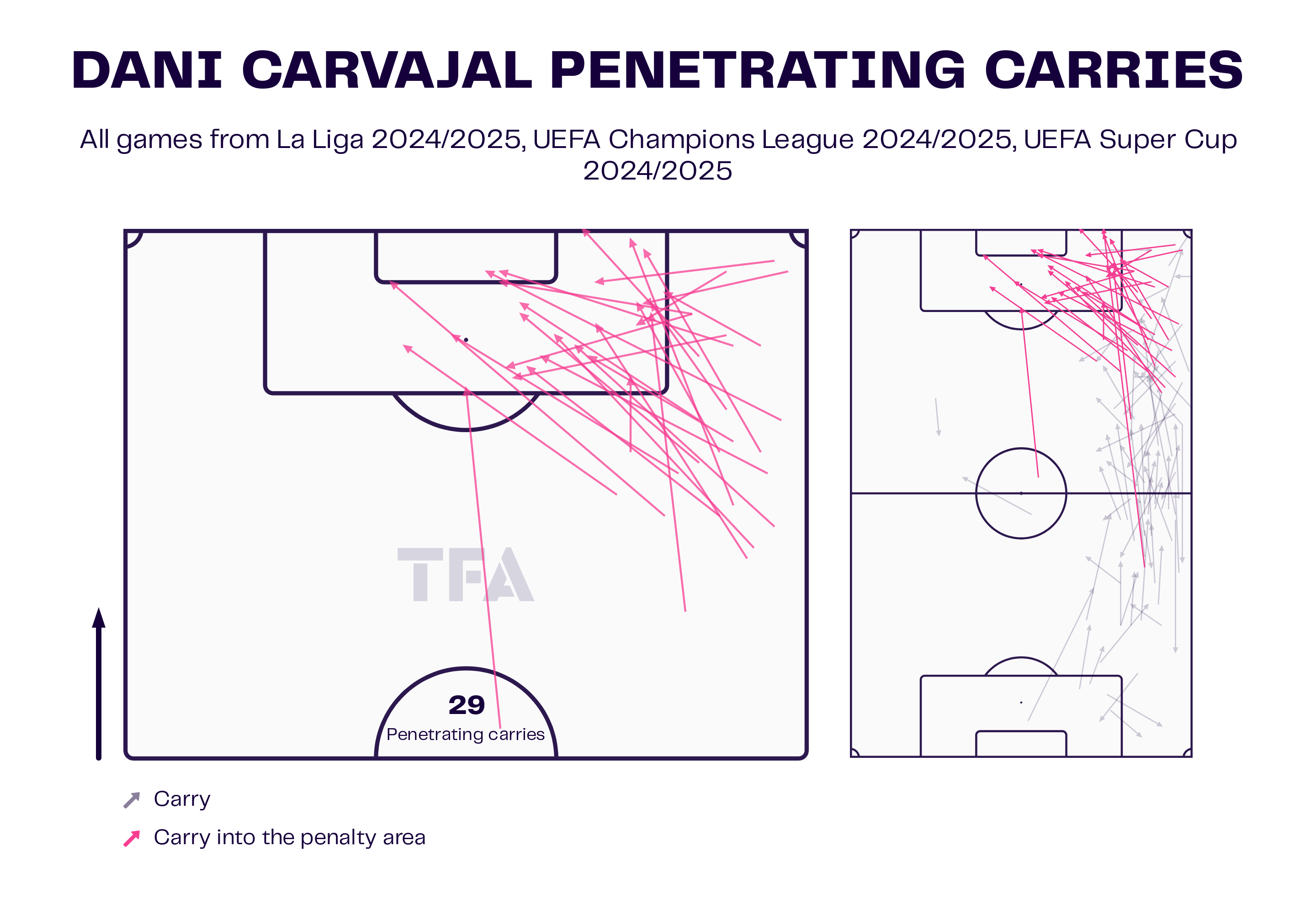
In addition, Carvajal is a committed player in the defensive phase, a fighter.
He is very intelligent and strong in duels and tends to be on the side with less volume of defensive actions per match.
What Should Real Madrid Look For In The Transfer Window?
Understanding Real Madrid’s troubles in different parts of the game, along with Kroos and Carvajal’s absences, we can quantify the requirements of their next right-back.
The first requirement is being a top-tier right-back — top-level experience in trophy competitive teams and international presence.
It would also be desirable to have a convenient contractual situation in the short term — preferably ending in 2025.
The ideal Dani Carvajal replacement sould be less than 30 years old, as Real Madrid needs a guarantee for the future.
Real Madrid should also look for a dangerous passer, someone even better than Carvajal.
For this scouting report, we’re prioritising in-possession metrics.
Let’s analyse three options using TFA’s xGold and data viz.
Trent Alexander-Arnold Vs Dani Carvajal – 77% Similarity According To TFA’s xGold
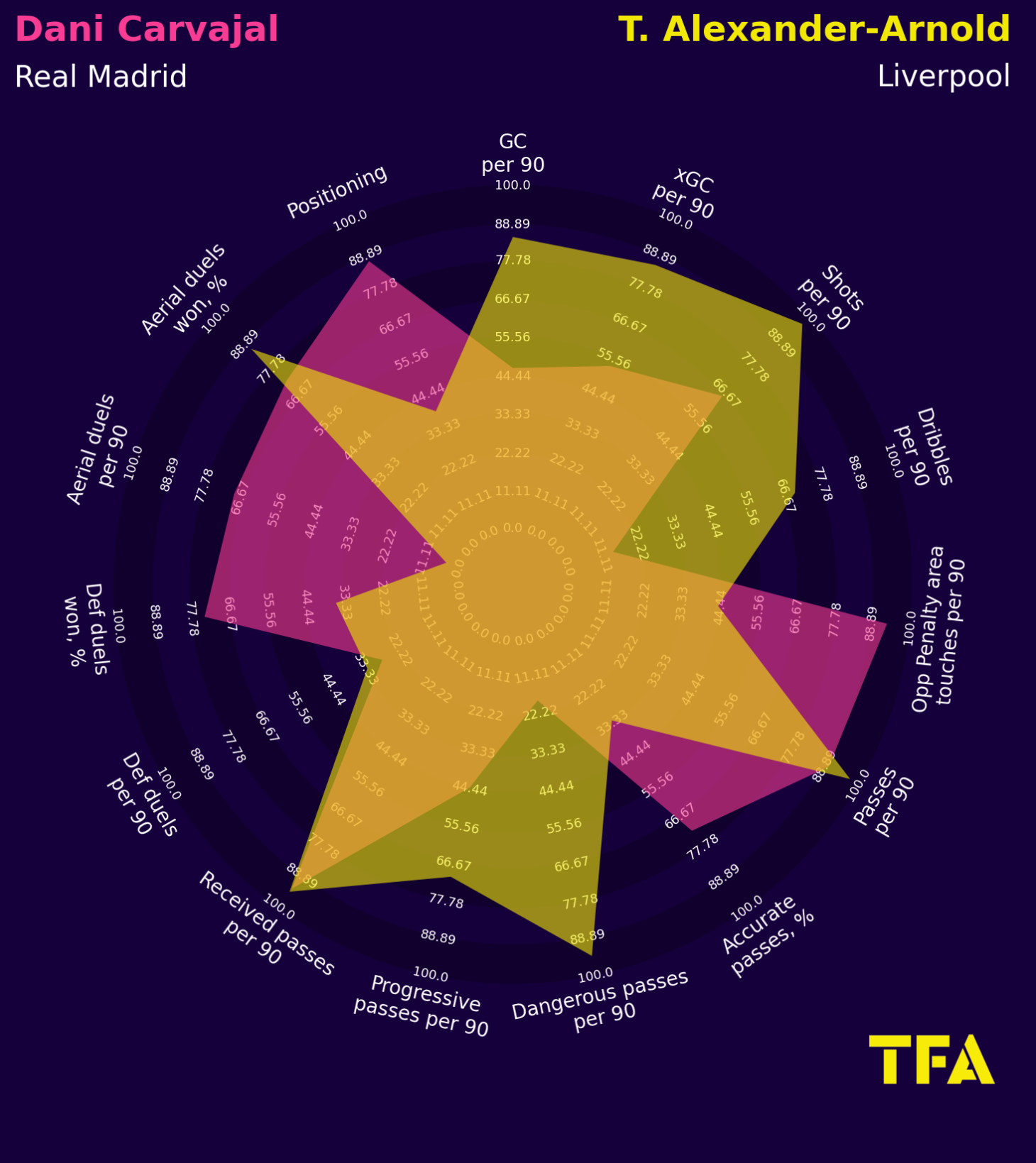
When it comes to passing, Trent Alexander-Arnold is one of the most technically gifted right-footed players in the world.
From wide and central channels, his striking is world-class.
From the right side, he could activate Vini, Mbappé, or Rodrygo through diagonal long passes.
His positioning would not be the same as Carvajal’s, as Trent Alexander Arnold plays in more central channels and does not tend to arrive at the final line pinning or something similar.
Somebody should pin wider and let him constantly move to the centre to build play.
Trent Alexander-Arnold Vs Dani Carvajal Heat Map
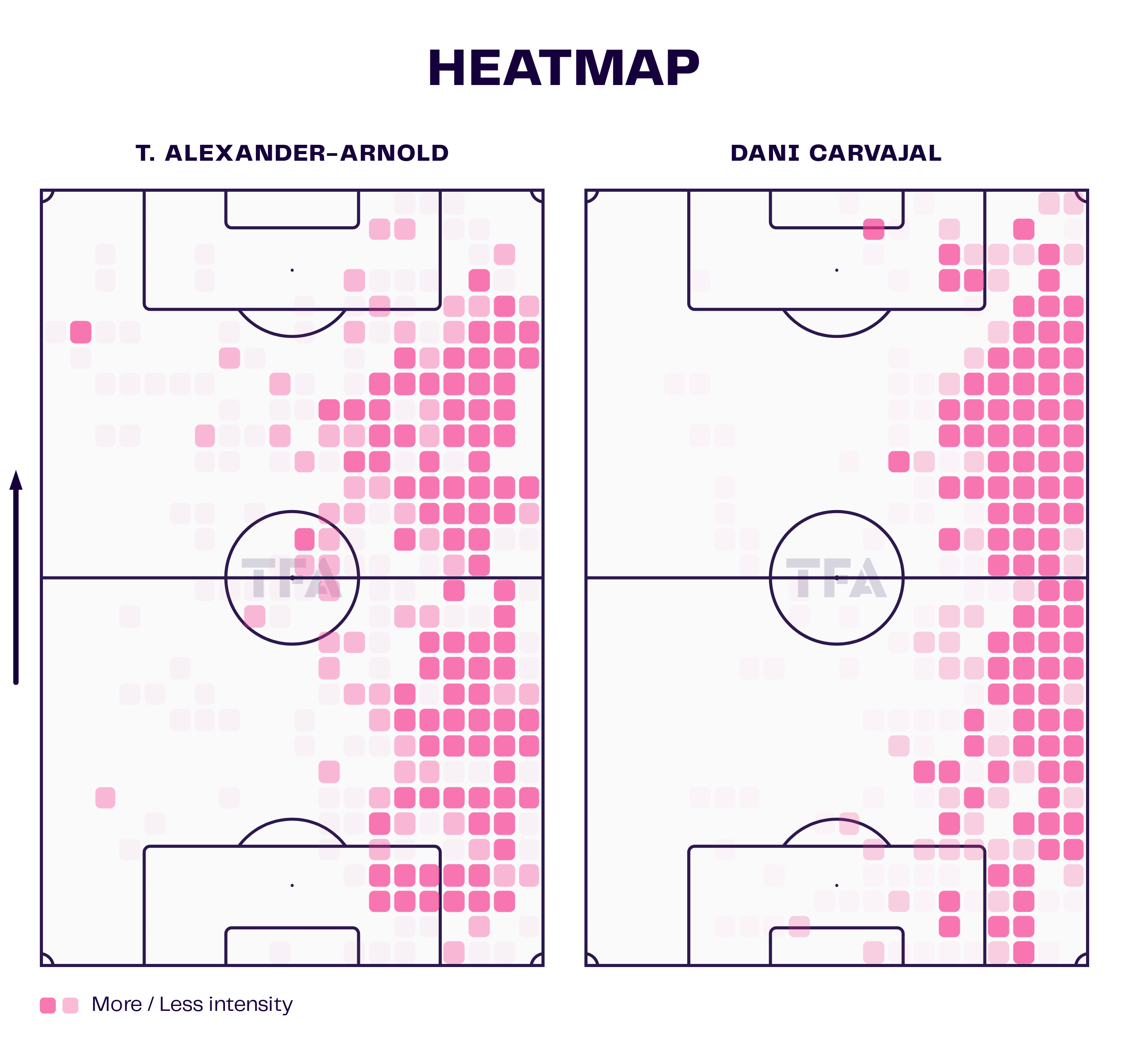
In the final third, he can make out-swinging crosses from wide or the half-spaces as well as early crosses from deep — he dominates many angles to cross dangerously.
Trent Alexander-Arnold Crossing Zones Map
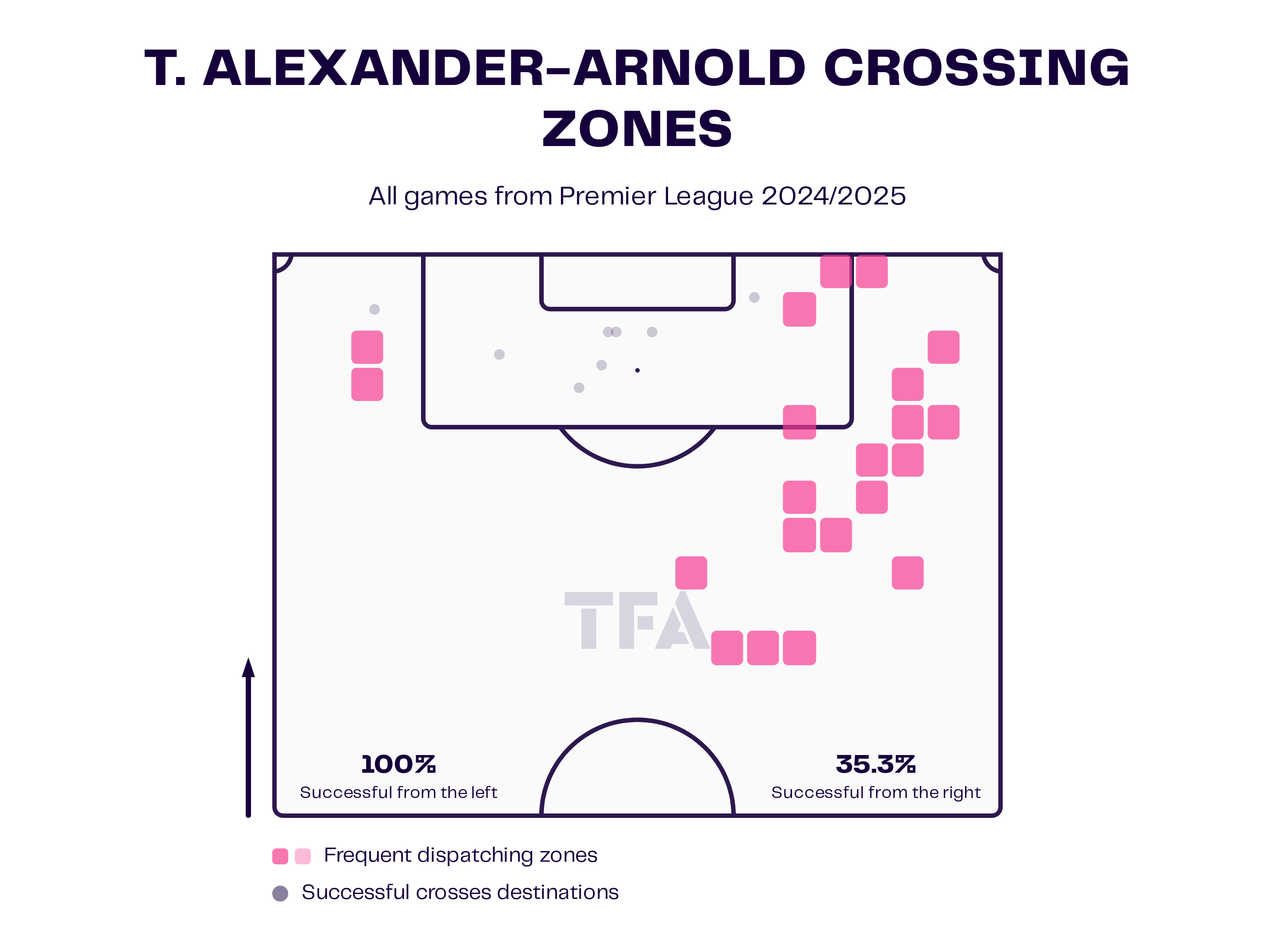
With Endrick and Mbappé in the squad, maybe TAA would have great teammates to make dangerous crosses.
Even if he gets freedom moving a lot on the pitch, in his role as a left-back at the England national team, he has shown that he is capable of making crosses from different angles on the left, too.
His passing accuracy is not good because he tends to try many complex passes.
Still, his vision and imagination are fantastic resources in the build-up and the last third, even without precision.
At Liverpool, he has been recognised as a purely offensive full-back.
The truth is that his defensive abilities are not great, but he is good at intercepting by positioning well and not running more than needed.
Joshua Kimmich Vs Dani Carvajal – 77% Similarity According To TFA’s xGold
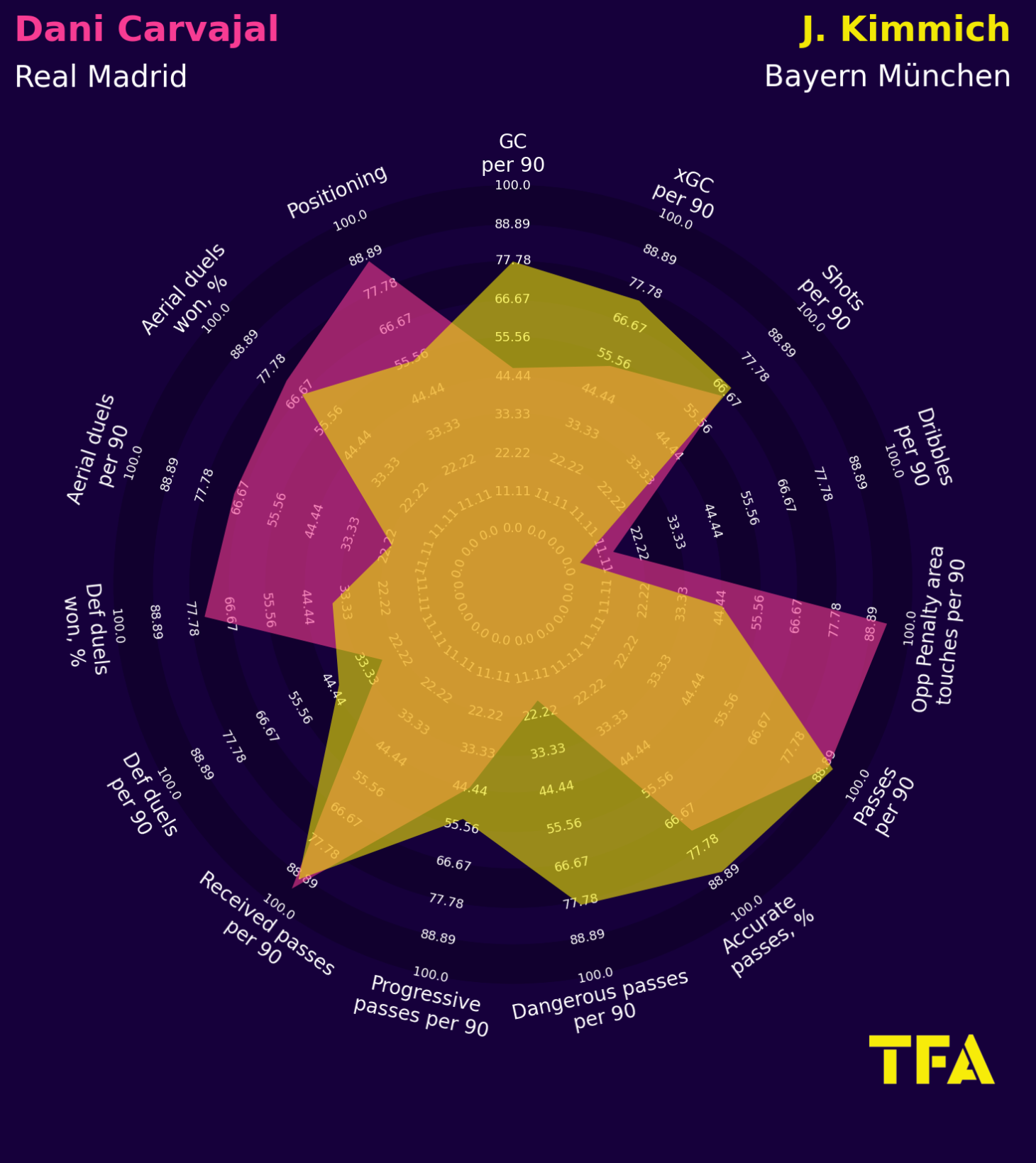
The main pro with Joshua Kimmich is that he is both a midfielder and right-back.
His volume of participation does not fluctuate in each position.
His passing technique and tempo make him the most similar profile to Toni Kroos in this list.
He can dictate the rhythm of the possessions with an insane accuracy while passing and has a unique vision.
Joshua Kimmich Progressive Passes Map
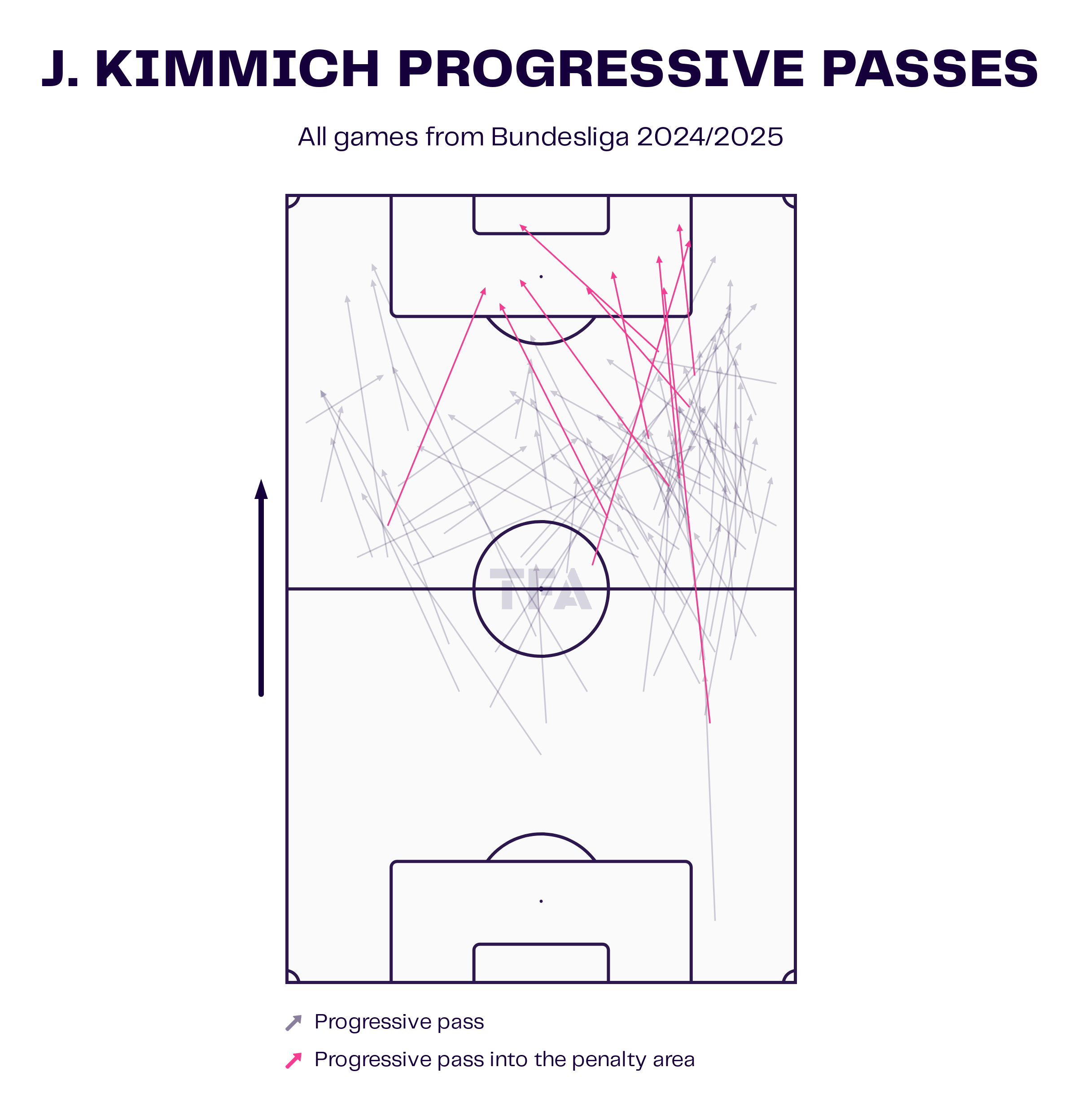
This season at FC Bayern, Kimmich is playing more as a centre midfielder with a destroyer next to him, but he has played many times as a right-back over the past season.
Kimmich can be Carvajal’s replacement in the short term and fix some troubles that Kroos’ departure caused by being his ‘successor’ in the long term.
This versatility is vital here.
However, as a right-back, his crossing is also great.
Joshua Kimmich Crossing Zones Map
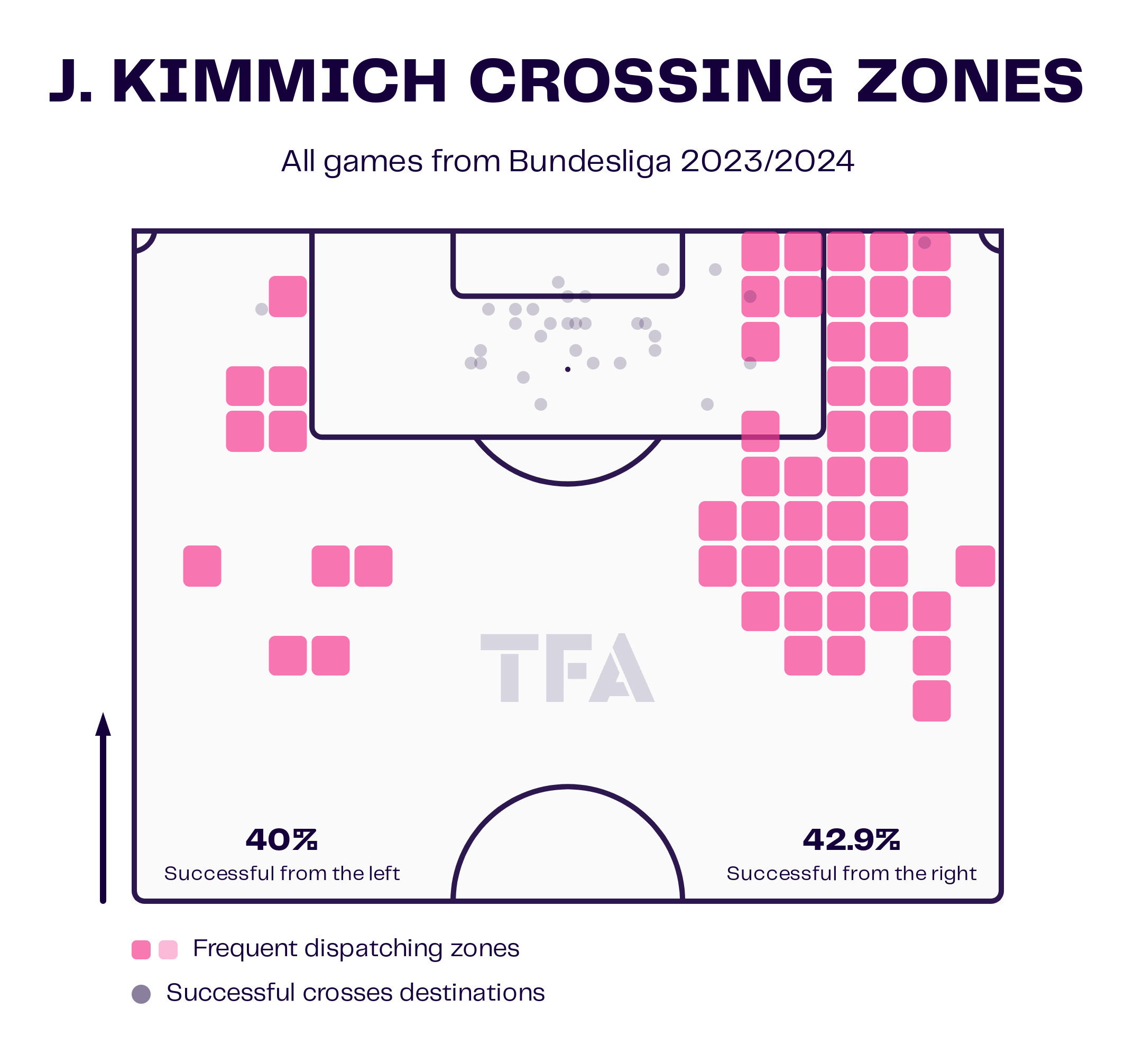
His successful crossing average stands out and has extra value compared to TAA, but he does not execute risky passes as him.
At 29 years old, Kimmich is logically a leader on the field.
He is capable of defending his zone well and always comfortably with the touchline close to him.
He feels good defending high, crashing bodies and anticipating.
He intercepts a lot.
Joshua Kimmich Defensive Territory Map
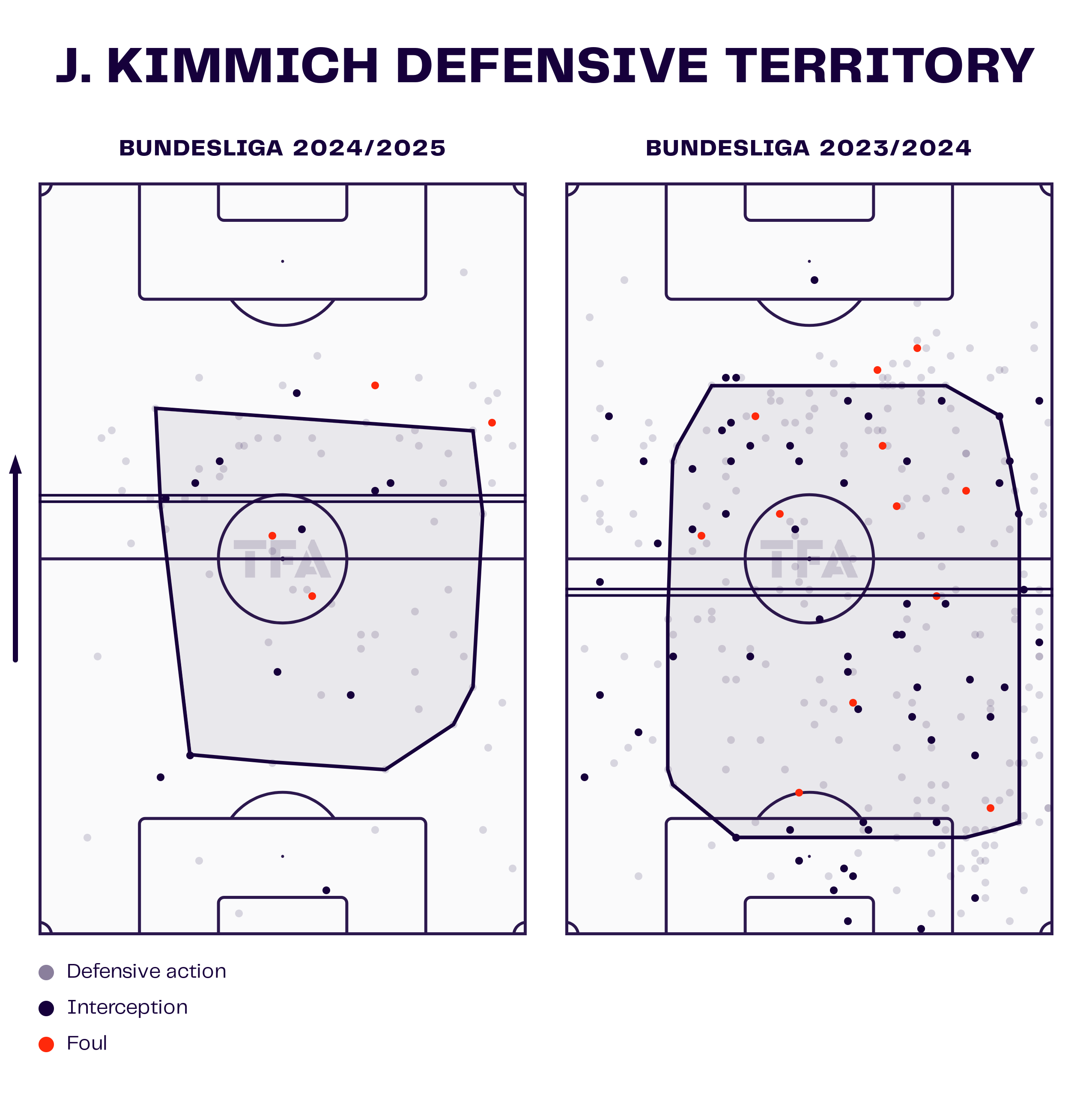
Kimmich’s best virtue is his intelligence.
TAA can be better in striking because he is exceptional as a right-back, but overall, Kimmich is still one of the best.
He will not position himself in the final line; he will always be near the ball, supporting it and offering passing lanes.
Denzel Dumfries Vs Dani Carvajal – 80% Similarity According To TFA’s xGold
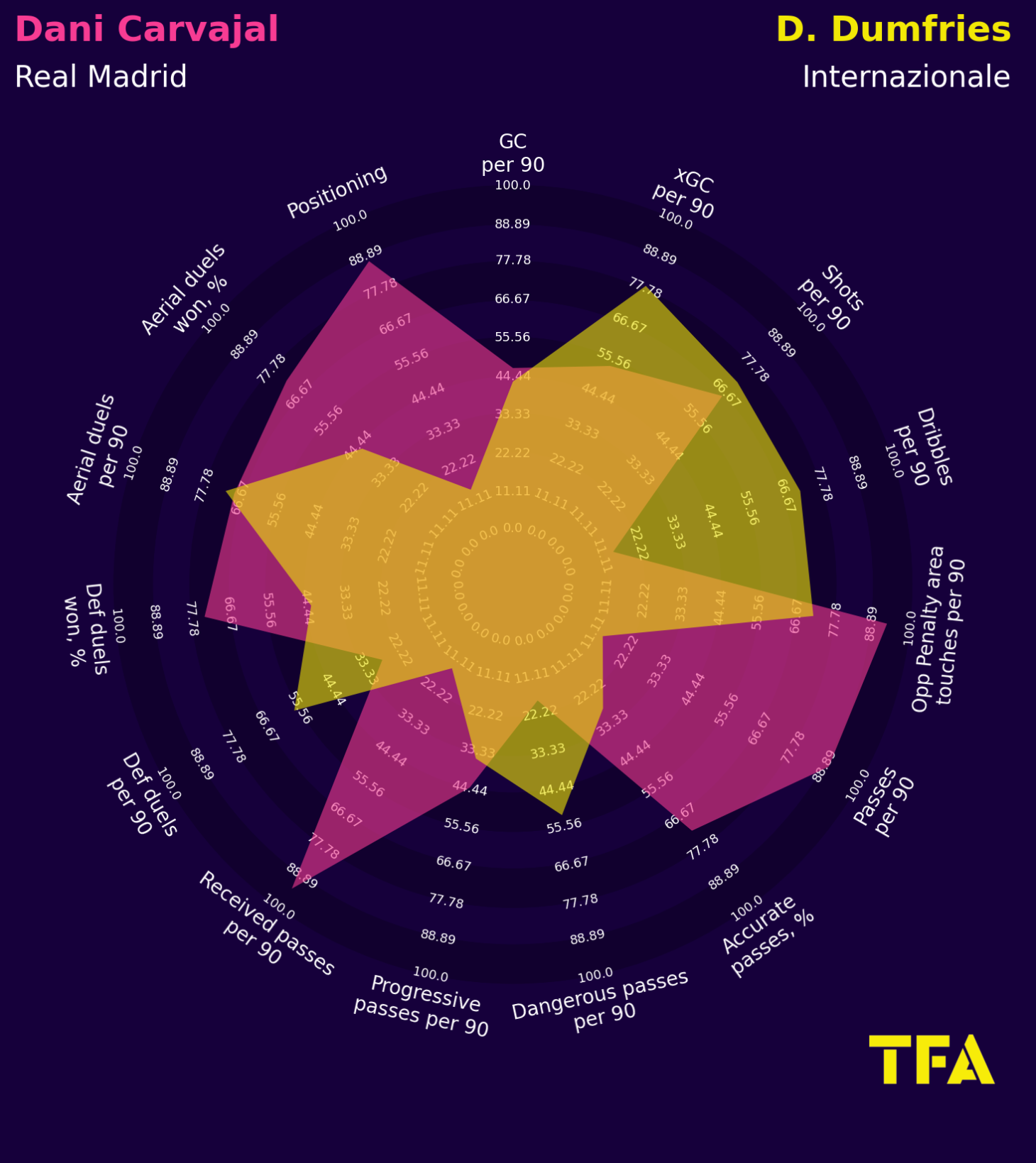
Denzel Dumfries is the most similar to Carvajal on the list, according to xGOLD.
He is more of a full-back than Kimmich or Alexander-Arnold, even though he tends to play as a right wing-back at Inter, but his minutes played this season have not been the best.
Denzel Dumfries Vs Dani Carvajal Heat Map
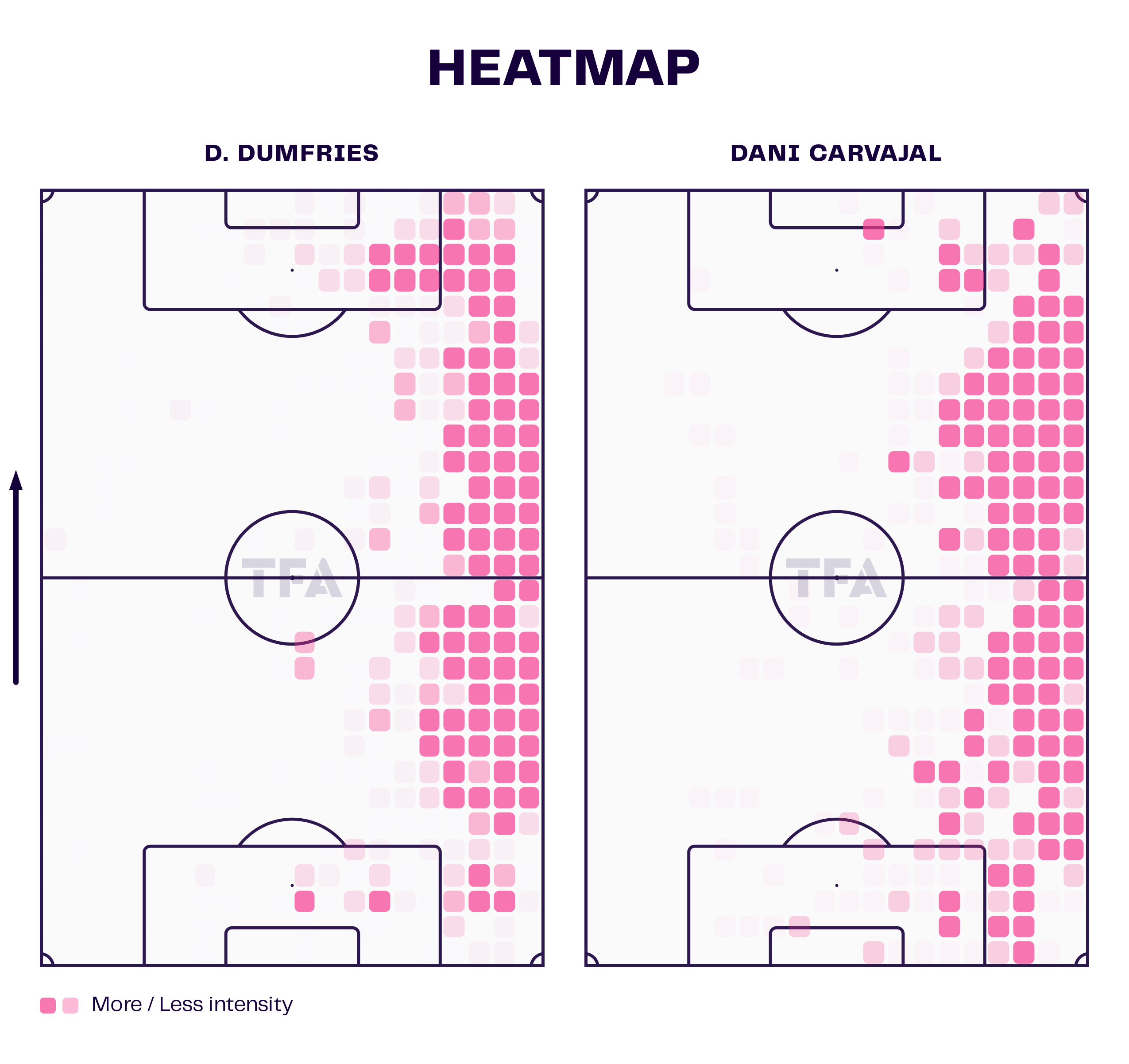
If Real Madrid really wants to replicate Dani Carvajal’s style of play, Denzel Dumfries seems like a good option.
With commitment and incredible lower-body power, Dumfries can own the wide channel in each phase of the game.
He could allow the other players to focus on the left and impose himself on attacking the weak side by positioning high.
He is also capable of leading the progress through carries with the ball at his feet.
Denzel Dumfries Ball Progression Map
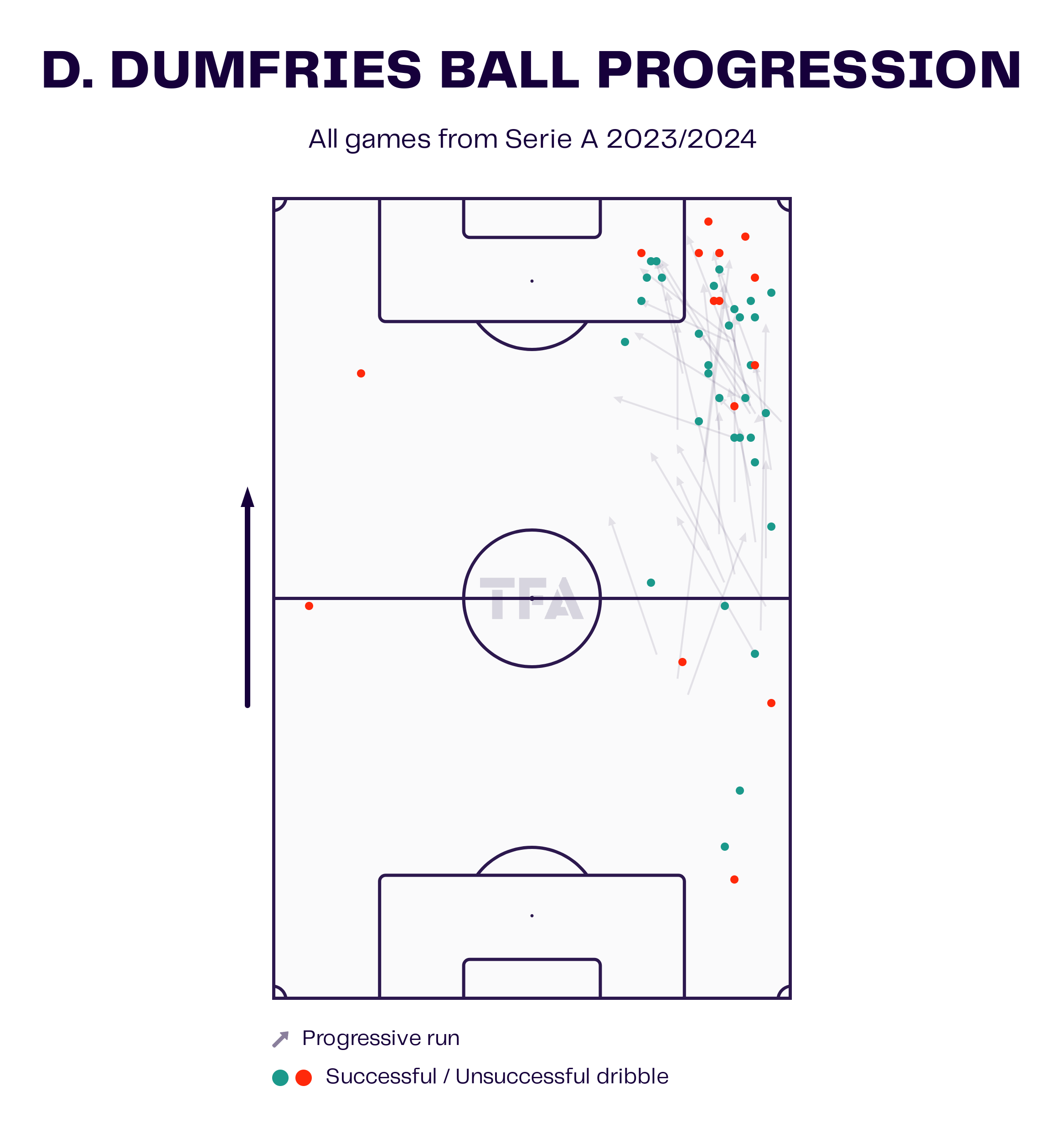
In the build-up, his link-up play is not as refined as the others on the list.
His passing range is not long, and he has a weakness in turning after receiving.
What he dominates is the oriented control under pressure.
He can prepare the carry, letting the ball roll or making a solid touch with a good body shape.
Once he has the ball, he is powerful, but usually in one direction, running with velocity and strength.
In the final third, he can finish plays by heading or shooting, arriving into the box by surprise.
His crossing technique lacks enough skill to be top-class, although he tends to create potential cutback situations.
It would not be a problem, given the tools that Real Madrid now have in their attack.
Conclusion
Tactically, Carlo Ancelotti will need to adjust his right back, considering Real Madrid’s structural problems.
It is vital for Ancelotti to make a move in one of the following two transfer windows.
If he wants to improve in possession and replace a little bit of what Kroos gave in the midfield, Kimmich would be the more similar option and can be both a central midfielder and a right-back.
If Real Madrid wants to make a big move and get a right-back star who can help in build-up and relationship terms, Trent Alexander-Arnold would be a signing that could have an impact for years.
However, his style of play is risky because of his volume of losses per match and his defensive deficiencies.
On the other hand, Denzel Dumfries is a more natural signing if Carlo Ancelotti does not want to change settings in his playing model.
He can replace Carvajal in the same role and is the more solid defensive option, but if he arrives, he will not give the squad a quality boost.
All 3 player’s contracts end in 2025, so they all have potential options to consider in the upcoming windows.
For now, Lucas Vázquez, Éder Militão, and Fede Valverde are the current options for the right-back position, and there is no natural replacement.
However, given Carvajal’s unexpected injury, if Real Madrid wants to compete at the highest level, they must make changes as soon as possible.

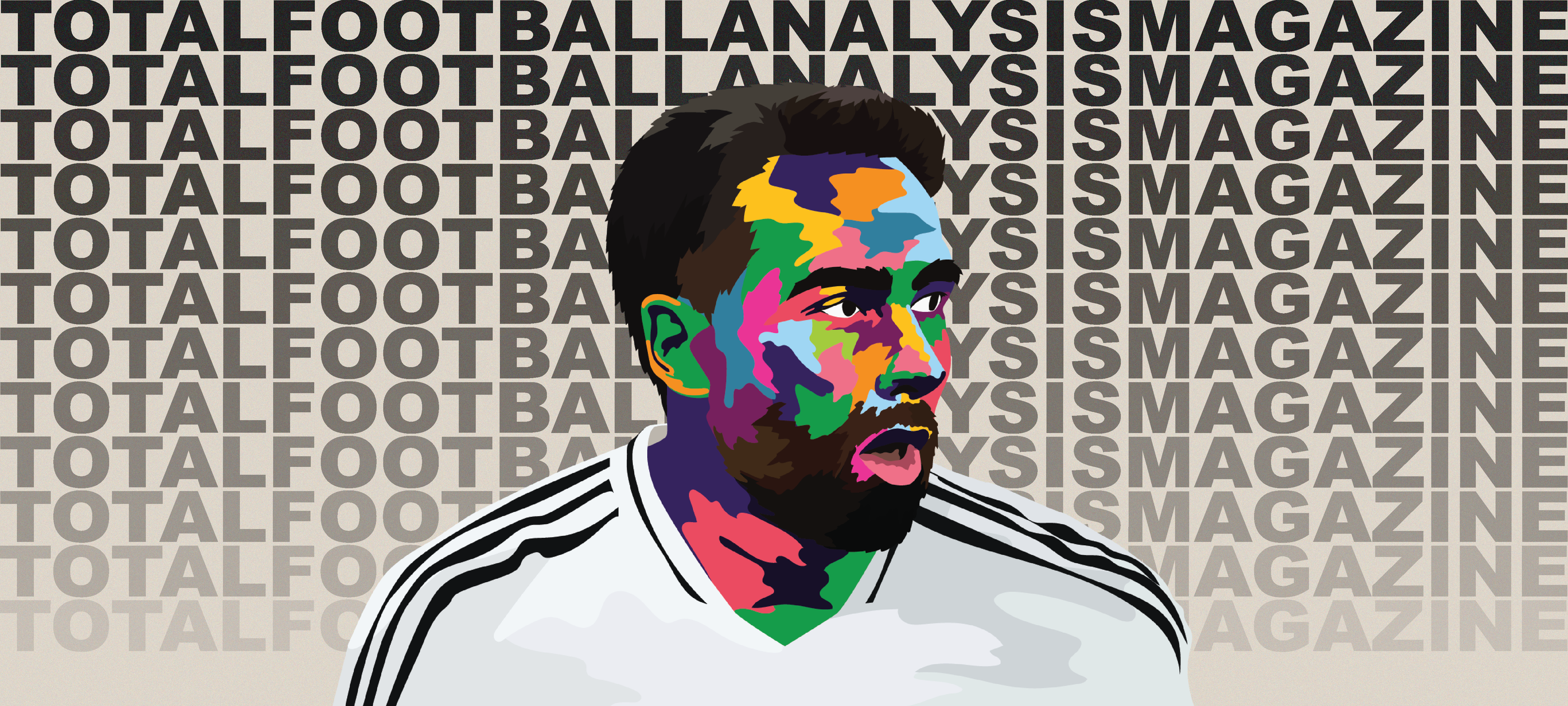




Comments